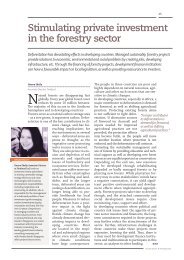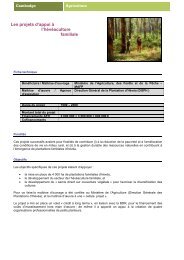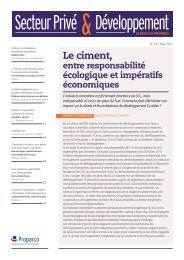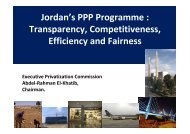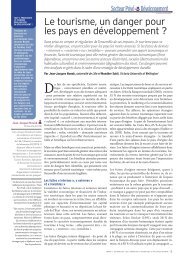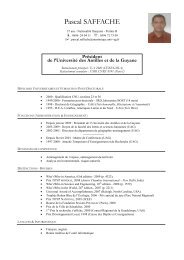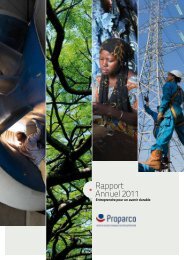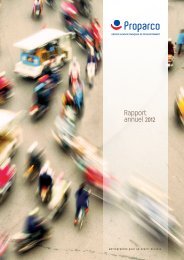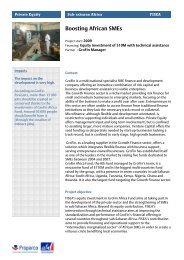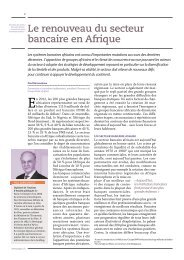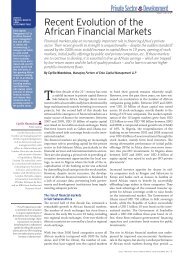Integrating Poor Populations in South African Cities - Agence ...
Integrating Poor Populations in South African Cities - Agence ...
Integrating Poor Populations in South African Cities - Agence ...
Create successful ePaper yourself
Turn your PDF publications into a flip-book with our unique Google optimized e-Paper software.
8. The Limits of the Government’s Actions<br />
especially <strong>in</strong> the case of general <strong>in</strong>terest or social vocation projects, and necessarily goes<br />
aga<strong>in</strong>st the <strong>in</strong>terests of other actors. In <strong>South</strong> Africa, <strong>in</strong> the Johannesburg city centre<br />
and elsewhere, xenophobic reactions are frequent and particularly difficult to <strong>in</strong>tegrate<br />
<strong>in</strong> an open consultation and participation process. Gett<strong>in</strong>g people to participate,<br />
benefit<strong>in</strong>g from their ideas, and at the same time conv<strong>in</strong>c<strong>in</strong>g all of the communities<br />
concerned of the validity of a project requires a delicate balance. Despite these<br />
implementation difficulties, and based on <strong>South</strong> <strong>African</strong> and French examples of<br />
participatory projects <strong>in</strong> which the populations are fully <strong>in</strong>tegrated, consult<strong>in</strong>g and<br />
work<strong>in</strong>g with populations appears to be fundamental. This is especially the case for<br />
projects <strong>in</strong> <strong>in</strong>habited areas or when re-hous<strong>in</strong>g is necessary. Inhabitants can then feel<br />
a form of urban belong<strong>in</strong>g that connects them to their neighbourhoods. Participation<br />
processes are above all essential to develop a territorial identity and generate peoples’<br />
<strong>in</strong>volvement with<strong>in</strong> the urban fabric.<br />
8.4. The Municipalities’ Involvement <strong>in</strong> Urban Development<br />
for Disadvantaged <strong>Populations</strong>: A Still Uncerta<strong>in</strong> Role<br />
120<br />
When one exam<strong>in</strong>es the government’s role <strong>in</strong> produc<strong>in</strong>g quality urban spaces for<br />
populations with modest <strong>in</strong>comes, municipalities’ territory and the scope of their<br />
responsibilities receive the closest attention. <strong>Cities</strong> represent the public level responsible<br />
for plann<strong>in</strong>g and implement<strong>in</strong>g urban development programmes to <strong>in</strong>tegrate all of their<br />
<strong>in</strong>habitants as harmoniously as possible. <strong>South</strong> <strong>African</strong> municipalities’ — and more<br />
specifically metros’ — responsibilities have evolved considerably s<strong>in</strong>ce 1994, and cities<br />
seem designated to guide their urban development. Furthermore, <strong>South</strong> Africa is often<br />
cited as a model of decentralization <strong>in</strong> Africa. However, cities must overcome nonnegligible<br />
difficulties.<br />
8.4.1. Municipalities’ Current Difficulties<br />
Recent and Ambiguous Responsibilities for Manag<strong>in</strong>g Urban Development<br />
Immediately after the end of apartheid, the national and then prov<strong>in</strong>cial governments<br />
were rapidly def<strong>in</strong>ed and set up. It took longer to successfully democratize local<br />
governments. The municipalities were powerful and well-structured (notably fiscally)<br />
<strong>Integrat<strong>in</strong>g</strong> <strong>Poor</strong> <strong>Populations</strong> <strong>in</strong> <strong>South</strong> <strong>African</strong> <strong>Cities</strong> © AFD 2009



